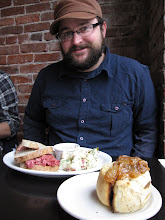
On the first Friday of every month, beer bloggers the world over combine to offer their views, opinions, and experiences on one uniform topic. We have the wonderful Mr. Stan Hieronymus to thank for it and there's a great explanation and backstory at Jay Brook's blog here.
This month's topic, The Beer That Did It is a call to all of us to think about the beer that made us really sit back and think about things, that one beer that completely opened up our minds to a whole world of history, tradition, people, buildings, techniques, ingredients, and change.
The session for May 2008 is being hosted by Boak and Bailey whose UK Beer Blog is always worth checking in on. So while my contribution can be read right here by clicking 'Read More', you can go to Boak and Bailey's to get links to other posts on this topic from around the world. It's very cool. So on with the show i suppose....
Up from the rhizome and down to the cone, hop bines are a work of beauty in their purely whimsical sense of growth. Given structure, the bine will follow its path climbing ever upward. The transitive harvest of diamonds. In a beer, hops are extremely easy to identify, they are bright, bitter, and refreshing at once. For a newcomer to beer, they are easy to pay attention to and by that I mean to say they’re at many times unavoidable.
I got into good beer as a hophead. Simple as that. I’ve since come to understand much more about beer and its subtleties and its intricacies, but there was indeed a time when tons of great craft beers were too malty, tripels were too perfumey, and too many other Belgians just tasted like rotten fruit. I’m not scared to admit it, i’m just glad i didn’t think i was cool enough to blog about it back then. Actually, i don’t even think there were blogs back then. Consider the stars aligned.
I am proud to say, like so many others, that the beer that did it for me is one of classic example, it’s one that is very important to the current craft beer landscape, and most vitally, its one i can come back to every once in a while and remark to myself with each sip, “Man, that’s a nice beer.” Ladies and gentlemen, a round of applause please for Sierra Nevada Pale Ale.
Put yourself in my sandles for a few minutes, will ya?
You’re in between your Freshman and Sophmore year of college. You’re a dirty hippie. You’ve got dreadlocks growing like lead hop bines out of your head and diving past your shoulders. You’re in a parking lot in Camden waiting for a concert to start. It’s like a Cannabaceae family reunion out there. (Wisely, you’d eventually learn to take your lumps and just stick with the hops.)
“One for three, two for five. Heady beeeeers!”
Before you can take so much as 10 steps down Shakedown Street, Dave, your traveling buddy for the weekend-who you just met in a summer class at the local community college-puts a Sierra Pale Ale in your hand. It’s been on ice all morning and it is one of the most amazing things you’ve ever swallowed. In the summer sun you stare at the flowers that grace the label, the water, the mountain range. It’s beautiful man.
At this point you don’t even know what beer is made of, but you know this beer is a miracle. So onward you go into life and before you know it you’re actually seeing this beer on tap. Sometimes it’s just as you remember it, sometimes it tastes like dirty metal and you’re disappointed. You wonder how something so eye opening, so flooring could actually taste…bad. So you move down the taps to something else, Bass probably. Wait a minute, why does this one taste like metal with pennies glued to it? Eventually you learn that some bars don’t clean their lines and that others can’t move a half of Pale Ale to save their souls.
Whether justly or not you now listen to professed hopheads and wonder if their journey is similar to yours, maybe they’re just a few beers away from discovering abbey ales or maybe they need a more distinct bridge. Maybe they’ll get a mouthful of Cascades in an American Brown or American Wheat and head off into a new direction. Or maybe their journey is theirs and theirs alone, you can’t even fathom a guess as to where it will take them. Maybe it’s better that way.
Somewhere between Dark Star and Harry Hood it all just clicked together though. One beer led to another, one style led to another, and one brewery led to another. Now you’ve got beer aging in the basement, you’re scrubbing labels off of bottles to fill with your latest fermented concoction and you’ve got a glass resting on your Sierra Nevada coaster as you type your entry into a worldwide celebration of beer, its culture, its people, its power, and its beauty.
Friday, May 2, 2008
The Session #15 - The Beer That Did It
Posted by
Dr Joel
at
7:18:00 AM
![]()
![]()
Subscribe to:
Post Comments (Atom)

1 comment:
It's interesting to see the different perspectives on Sierra Nevada Pale Ale on the two sides of the pond. Here it's still a rare and exotic novelty -- of course, your hardcore beer geeks know about it, but it's starting to appear at a couple of trendy pubs in London.
Whereas reading through these Session posts, those American bloggers who have mentioned it seem slightly ashamed or dismissive of it.
I think it's a good "gateway drug", and a good beer in its own right.
Post a Comment